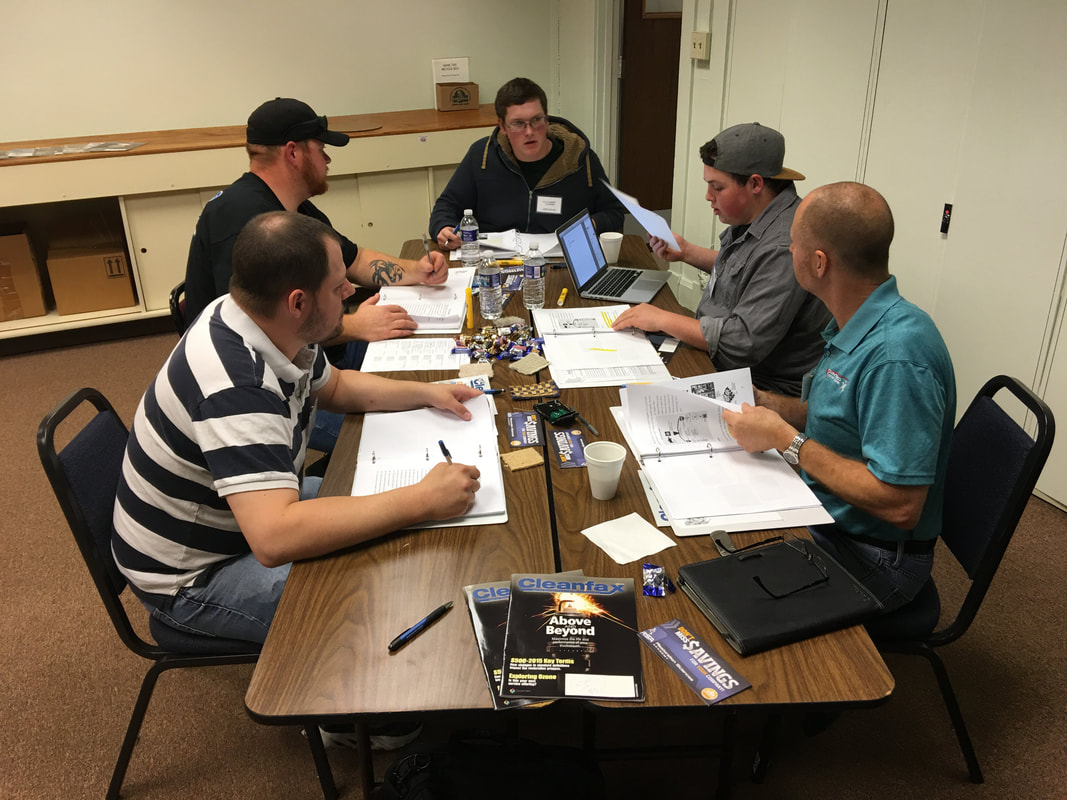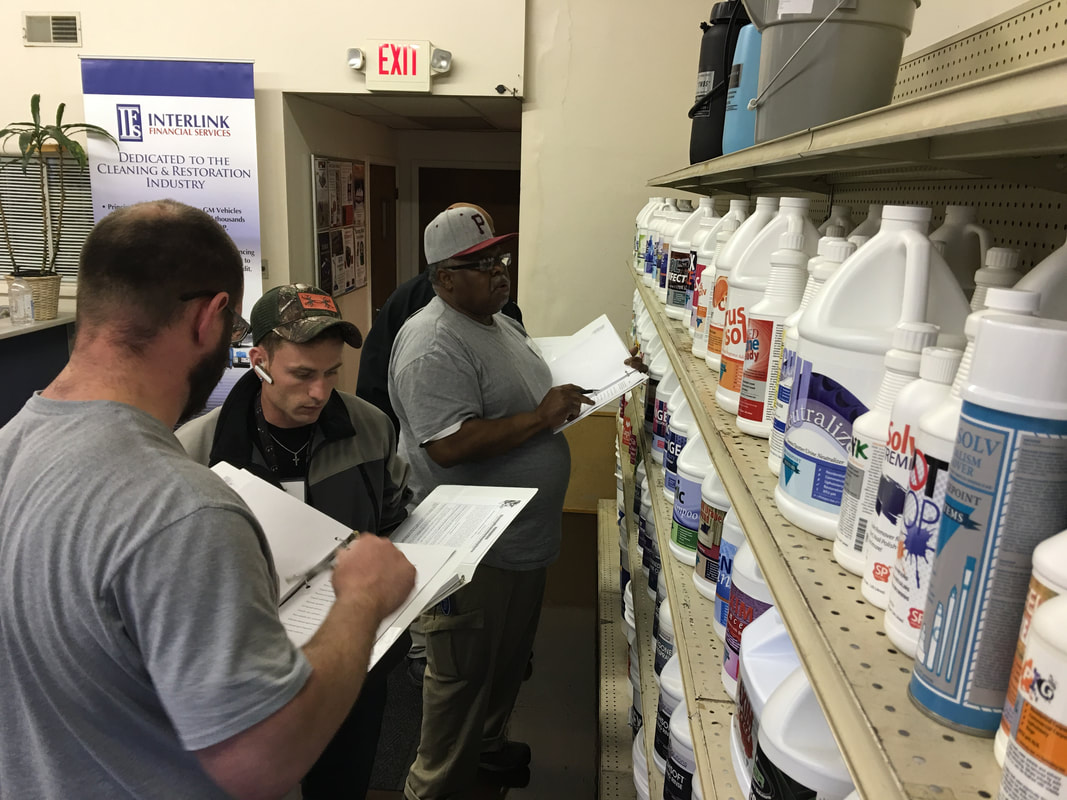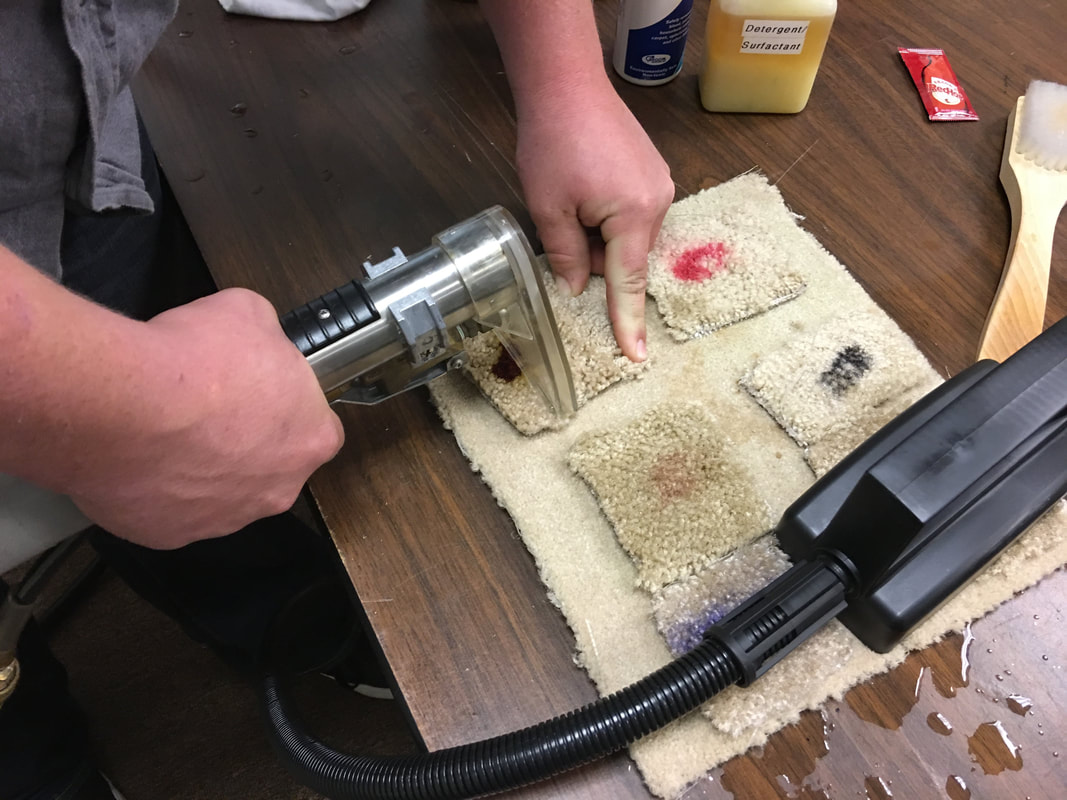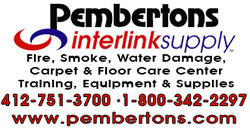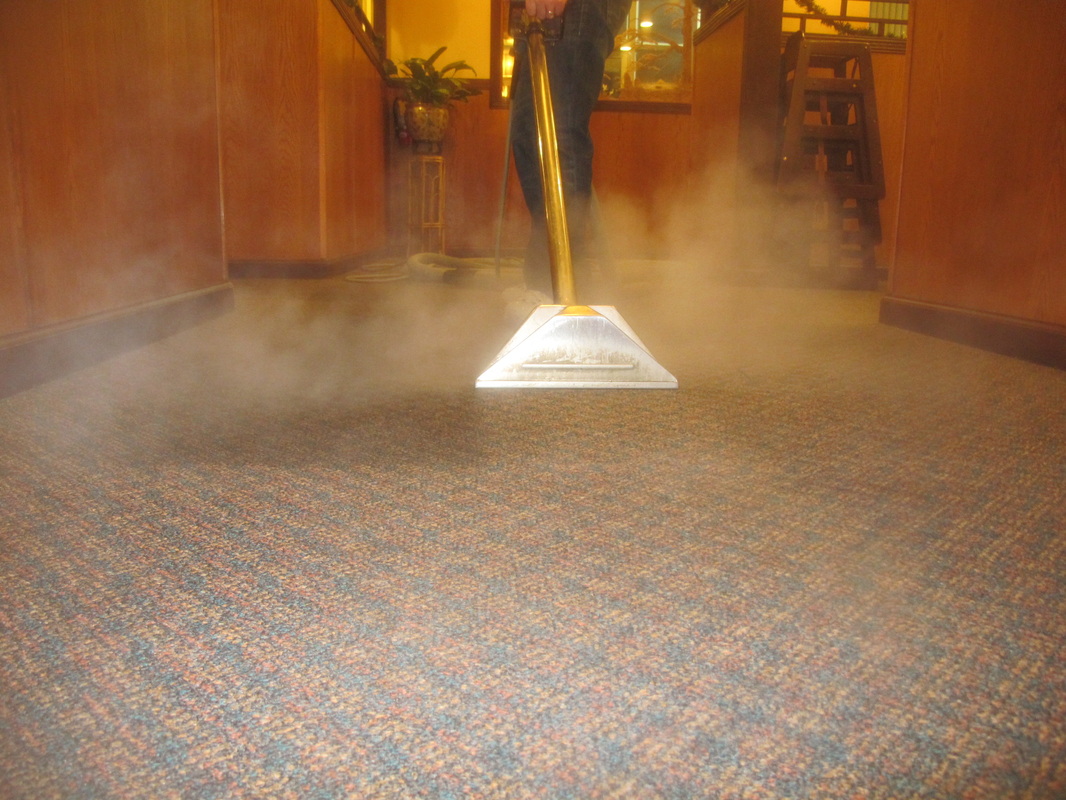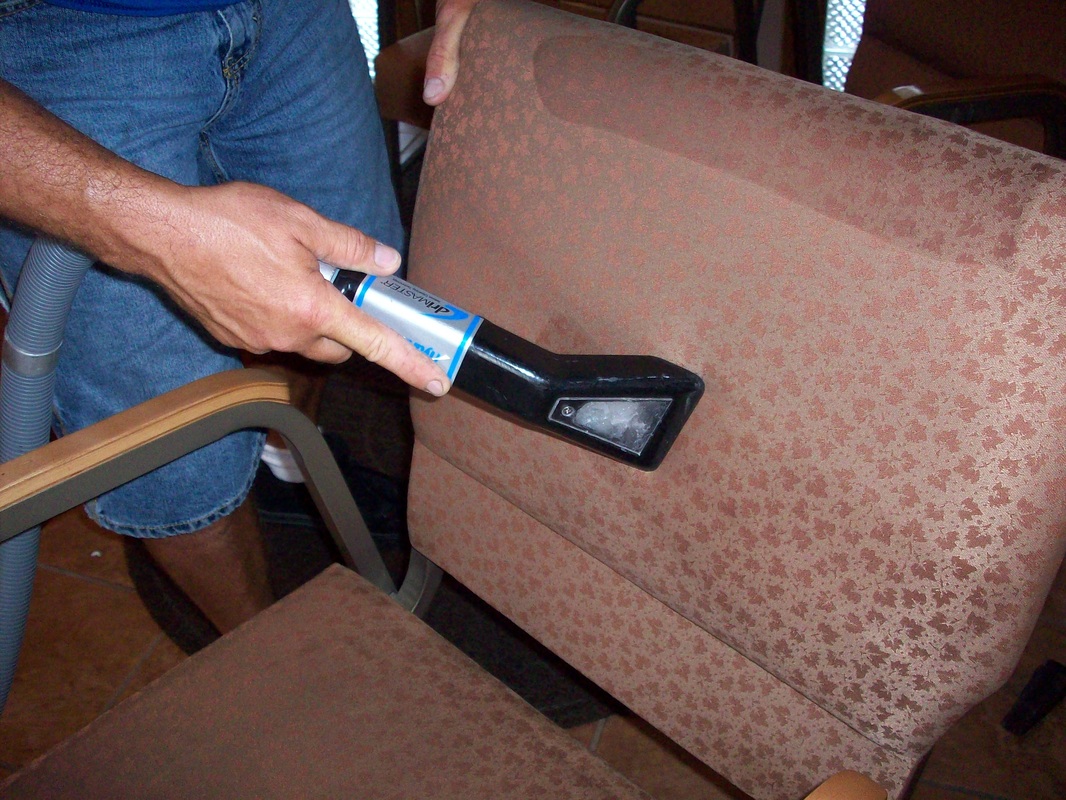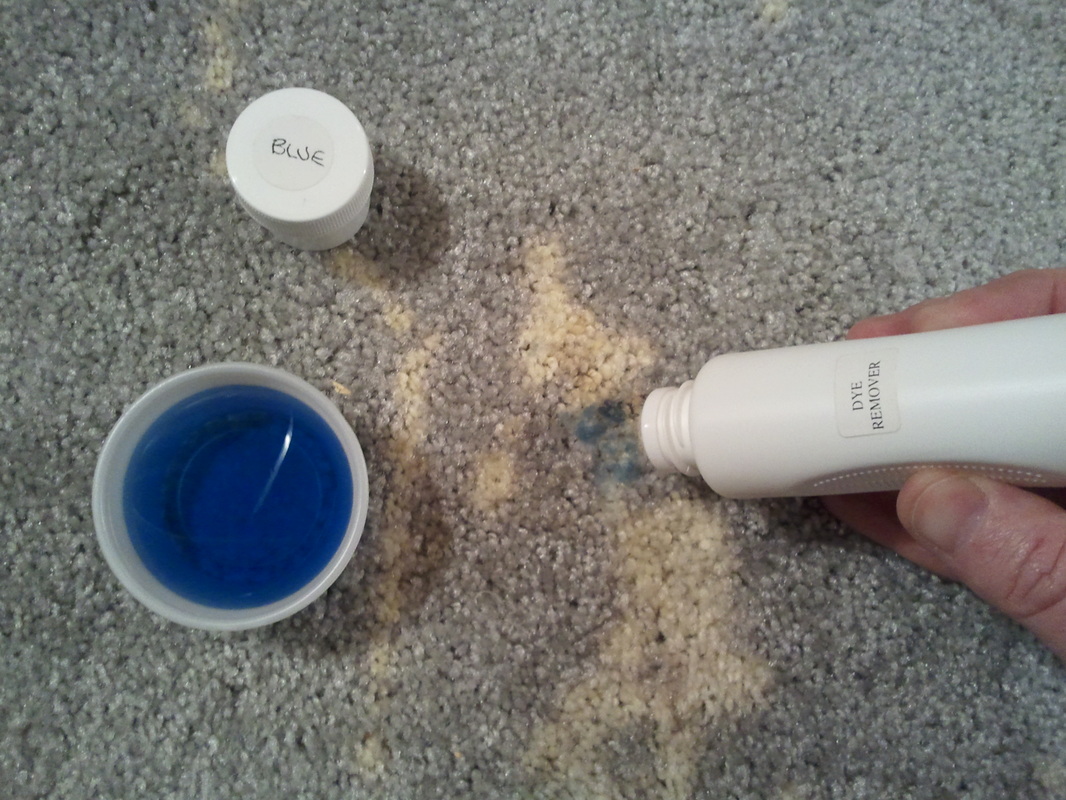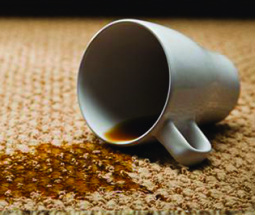
"I would like to thank you once again for your time as well as your incredible knowledge. Your class really brought a lot of important cleaning techniques and I was able to grasp and obtain the information much more easily with the way you explained and broke each step down. You are an amazing instructor and I’m truly grateful to had the opportunity to meet you and much more honored to call you a friend. I look forward to taking my new found knowledge straight to the field of this amazing, growing Industry."
Charlie D.
Charlie D.
|
Upcoming Workshops Monday and Tuesday, June 19-20 Visit this link to register $349 per student To register for any session at Pembertons, call (800)342-2297 |
Pembertons
5825 Smithfield St. McKeesport, PA 15135 Workshops Designed for You! Join Jeff Cross, media director of Cleanfax, for a carpet cleaning, furniture cleaning, color repair or spot and stain removal class or workshop. You will learn all procedures recommended by the IICRC plus advanced methods to handle virtually any cleaning challenge. |
To register for any session at Pembertons, call (800)342-2297
|
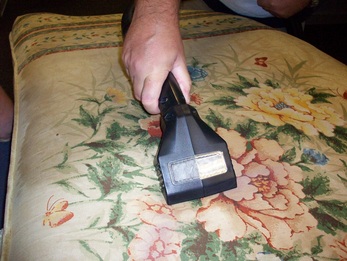
For the absolute best in IICRC Carpet Cleaning & Furniture Cleaning Classes and Workshops in the Pittsburgh area, this page is for you!
IICRC Certification classes in carpet cleaning and upholstery (furniture) cleaning at Pembertons Interlink Supply is exactly what you need to increase technical skill and become the best cleaning technician in the industry. This type of training is perfect for the entry level technician to learn necessary skills or the advanced technician to brush up on old ones or learn a few new tricks of the trade when it comes to care and cleaning of upholstery and furniture. Don't miss out, sign up today!
Scroll down for class descriptions. For information on Totally Booked University, click here.
To register for any session at Pembertons, call (800)342-2297.
IICRC Certification classes in carpet cleaning and upholstery (furniture) cleaning at Pembertons Interlink Supply is exactly what you need to increase technical skill and become the best cleaning technician in the industry. This type of training is perfect for the entry level technician to learn necessary skills or the advanced technician to brush up on old ones or learn a few new tricks of the trade when it comes to care and cleaning of upholstery and furniture. Don't miss out, sign up today!
Scroll down for class descriptions. For information on Totally Booked University, click here.
To register for any session at Pembertons, call (800)342-2297.
Learn how to safely and effectively clean carpet and furniture and avoid costly mistakes!
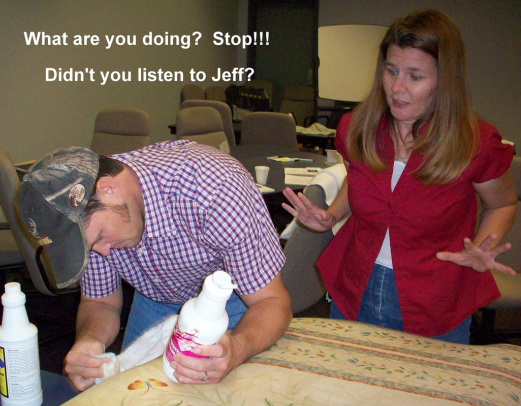
There are tens of thousands of carpet and furniture cleaning companies in the United States.
Competition can be tough in your marketplace. Learning technical skill and solid procedure to clean carpet and furniture is absolutely necessary and certification training for all technicians should be part of your company's business model.
Remember, your customers assume you will do the best job possible. Carpet and furniture cleaning expertise is what they expect. An IICRC approved cleaning seminar is a great way to accomplish this.
Join Jeff Cross, executive editor of Cleanfax, for a carpet cleaning, furniture cleaning, color repair or spot and stain removal class or workshop. You will learn all procedures recommended by the IICRC plus advanced methods to handle virtually any cleaning challenge. Keep reading for seminar descriptions.
Attention Business Owners:
Besides technical training, take advantage of some of the industry's absolute best marketing and business building workshops.
Visit Totally Booked University for a schedule of events.
Need a private IICRC Carpet Cleaning Technician (CCT) certification workshop or IICRC Upholstery and Fabric Cleaning Technician (UFT) certification workshop at your location?
Click here to learn more
Visit Totally Booked University for a schedule of events.
Need a private IICRC Carpet Cleaning Technician (CCT) certification workshop or IICRC Upholstery and Fabric Cleaning Technician (UFT) certification workshop at your location?
Click here to learn more
Carpet Cleaning Technician
This comprehensive carpet care seminar, taught over two days, includes modules on fiber and carpet identification, advanced cleaning techniques and methods, problem solving methods and spot and stain removal. We cover cleaning chemistry in detail so you understand the reaction of soils and cleaning solutions. You will learn advanced methods and "tricks of the trade" that will make you an expert cleaning technician. Carpet cleaning certification training classes are perfect for beginnings or veterans alike. Keep up with advanced techniques as the industry is constantly changing and improving.
|
Upholstery Cleaning Technician
This valuable, two-day seminar will keep you out of trouble. Many cleaners avoid furniture cleaning, but there’s no reason you should. We talk about all fiber types, how to clean them, what method of cleaning works best – and at the same time, works safe. Furniture cleaning can become a tremendous profit center for your business. Cleaning chemistry, spot and stain removal and problem-solving techniques are a large part of this class. Upholstery or furniture cleaning certification training classes are a MUST for cleaners to learn skills that will keep them out of trouble. Be ready to learn how to care for even the most delicate fibers and fabrics.
|
Color Repair Technician
This workshop will teach you how to become a spot and stain removal master, and how to repair color loss either from your own stain removal efforts or from bleach discolorations and other color loss related issues that you see every day. Color repair may seem intimidating, but with hours of hands-on instruction in this two-day class, you will see how easy it is. Every carpet cleaner should have these skills. Your customers will call you to fix their "bleach spots" when they know you offer this type of service. This color repair certification training class is required to attain IICRC Master Textile Cleaner status. Part of the certification test is based on hands-on training.
|
Spot and Stain Removal
Although not a certification class, this continuing education workshop shows you how to identify spots and stains, choose the best cleaning chemistry (solutions), methods for removal and more. Learn how to remove mustard, furniture stains, Kool-Aid and other tough dyes, ink, permanent marker, iodine, wine, grape juice, copier toner, fingernail polish and other cosmetics, and more. Specific challenges such as old urine stains, removing filtration lines, how to identify spot and staining substances and "thinking outside the box" techniques will make you a master in spot and stain removal.
|
Removing carpet cleaning and furniture cleaning detergent residue and foam
Check out this video. It shows what it takes to rinse foam from an easy, smooth surface. Can you imagine if this was on carpet? A small amount of foam can kill the toughest vacuum in a truckmount. The amount of detergent was just one "squirt" into the sink! What do you do when you encounter foam in carpet? You may need defoamer... and be sure to turn off the heat as cold water will rinse foam out easier.
|
|
|
Here is a really cool document on allergens and cleaning. You can print and hand to your customers.
Faster Furniture Cleaning Production
This carpet cleaning mantra is repeated by many cleaners: Get it clean and get it dry — fast.
Furniture cleaners take a different approach, because furniture is not as “forgiving” if an aggressive or “speedy” cleaning process is used.
But there are steps you can take to speed up and streamline your furniture cleaning process, without sacrificing quality or causing damage to texture or color.
As an example, let’s assume that you have several pieces of furniture to clean. You have tested the pieces, and determined you can safely clean them with hot water extraction.
Preparing the job
After you inspect the furniture to be cleaned, set up your work area. Bring in all the tools and chemicals you need and set them up in an organized manner.
Arrange the furniture in a “production line.” This can be in a line, in a circle — it depends on the layout of the room.
A commercial location typically has more area to work in, while many residential locations leave you fighting for space.
Be careful of hard floors. No matter how careful you are, you may drip water or chemicals onto the floor. A drop cloth will protect the floor.
The production line
Precondition the first piece, lightly dampening all areas that are “touch points” on the piece. Work the solution into the fabric with a horsehair brush.
There is rarely a need to precondition the backs or sides of the piece. The rinse agent in your machine will remove light soils.
At this point, a two-man team is best, if there are multiple pieces to clean.
Let’s name the workers Worker A and Worker B.
After the first piece is preconditioned and agitated, Worker A can begin cleaning (starting with the back and sides and allowing dwell time for the areas that are heavily soiled).
When halfway through the first piece, Worker B preconditions and agitates the second piece.
After the first piece is extracted, Worker A moves to the second piece and Worker B moves back to the first piece for inspection.
If there are any areas that are dirty or dull in appearance that need additional cleaning, Worker B can reapply chemical and agitate one more time with the horsehair brush.
Then, Worker B moves to the third piece to start the process over again (precondition and agitation), while Worker A goes back to the first piece after the second piece is cleaned.
Worker A extracts the areas on the first piece that were treated a second time, and then moves to the third piece.
Worker B, after completing the preconditioning and agitation of the third piece, moves to the second piece for the initial inspection.
The process continues until Worker A is on the final piece. It’s now time to perform the final inspection and to add deodorizer or protector if that is part of the job ticket.
Final touches
While Worker A concentrates on completing the cleaning, Worker B can begin closely analyzing final cleaning results, inspecting for spots, stains and anything else that needs more attention.
Worker B can use a white, cotton towel to remove more soil and moisture from all transition areas.
It is important to keep the production line moving. The key is to never stop the action. Time is money.
Always make sure that Worker B performs a thorough inspection — at least twice.
If Worker B has nothing to do physically, he should spend his time inspecting previous work and toweling off damp areas. He’s also the one to keep the machine full of hot solution and to remove wastewater.
This system works great with two-man teams and multiple pieces. If you only have one or two pieces, one person can easily handle this type of production.
If you are cleaning a large amount of furniture, such as in a large home, commercial building, etc., a production line will save you money on labor.
Woes of the Nose
mal·o·dor
/malˈōdər/
Noun: A very unpleasant smell
Synonyms: Stench - stink - reek
Go online and perform a simple Internet definition search of a “malodor” and you can see why your customers need your services.
You all have walked into a home, business or other structure and have been struck smack in the face with an unpleasant odor and wondered how the occupants were able to do anything inside without the aid of a full-face respirator.
Whether removing pet urine odors from carpet, odors from a water damage situation or that unfortunate event in history when you cracked open the lid of the truckmount waste tank… it takes technical skill to know how to use chemistry and technique to remediate malodors.
Let’s look at a few odor situations and some practical tips to help you with your own technical skill.
Porous surfaces
The U.S. Environmental Protection Agency (EPA) doesn’t allow a “disinfection” claim on porous surfaces like carpet, fabric or furniture. They will allow a “sanitize” claim for carpet.
“To properly sanitize a carpet, you must use an EPA-registered product that has the ‘carpet sanitizer’ claim identified on the product label,” according to Jason Capon, the director of marketing and education with Benefect.
According to the EPA, other materials, like furniture and fabrics, can only be “deodorized,” Capon added. The real-world problem exists that once water saturates fabrics, upholstery or carpet, any microorganisms that may be lodged in those fibers can become active.
“It really doesn’t matter if it is bacteria or mold. It replicates quickly and can produce some offensive odors. The longer the material is saturated, of course, the more microorganisms multiply and the stronger the odor becomes,” Capon said. He said to look for a product to use that is labeled to deodorize porous surfaces, and has proven efficacy as well.
“Using an EPA-registered product with the carpet sanitizer and deodorizer claims is an excellent tool for dealing with heavily contaminated contents,” Capon added.
Nancy Ewing, vice president of Anabec Systems, said that using products that are benign and safe — yet extremely strong in attacking the stronger strains of mold or bacteria — is the way to go. “You need to start with a detergent with tremendous contact and penetrating ability,” she said, “and then follow that with a disinfectant that is able to destroy odors from mold and bacteria.”
What about masking deodorizing products, which are popular in the industry today? “You must choose a product that will destroy odors at the source, not just mask them,” Ewing said.
Odors in carpet
Carpet disinfection is essentially a challenge of topography, believes Jeff Heyd, director of sales at Concrobium Professional Restoration Products.
“We’re not dealing with a smooth, hard surface, so even after thorough cleaning, odor-causing bacteria can remain nestled deep in the carpet structure,” Heyd said.
In addition to cleaning and drying of the affected carpet, proper application of the right disinfectant can deal with hidden microorganisms without leaving harmful residue. “Next generation botanical disinfectants don’t require rinsing and offer a much safer toxicity profile than traditional antimicrobial solutions," Heyd stated.
Capon added the following thought to the discussion on carpet deodorizing: “One-step cleaner sanitizer products are a much better choice for carpet cleaning because of how they are formulated to penetrate into, but not bind, with the fibers. It’s the sanitizer’s ability to kill microorganisms, whether bacteria or mold, that will eliminate offensive odors most effectively.”
As we all know, carpet can harbor many odors, and using an enzyme is often a great deodorizing tool.
“A bio-enzymatic liquid is very effective at safely getting to the source of the odor and eliminating it, especially pet and urine stains,” according to Carol Abrahamson, the communications manager at Vaportek.
By first removing as much of the odor source as possible, and then following instructions for a quality bacterial/enzyme product, remaining odor causing bacteria will be broken down.
Problem solved. End of story?
Waste tank woes
Have you ever opened a waste tank in the middle of August and taken a deep breath? If you did, you remember it vividly.
“This same enzyme used in carpet can be used to rid waste tanks of foul odors that may offend customers and technicians, especially in the summer,” Abrahamson said. “Just add a few ounces to your emptied waste tank on Friday and, by Monday, odors will be gone, without causing corrosion or pitting.”
Proper application
No matter which product you choose to use for odor control or disinfecting, it is vital you follow manufacturer recommendations and industry best practices.
“Field employees repeatedly admit to not applying products for the proper amount of time and also not rinsing away the product, as directed on the label,” according to Nicholas Levy, national director of sales for Hygienic Solutions US.
What does this do? It results in eliminating the product’s kill claim. It also likely leaves behind potentially dangerous or corrosive residues. With more products on the market advertising one to three minute kill claims, the ability to disinfect without wasting product is highly increased.
“As I travel the country, training many restoration companies on the use of these high-level disinfection chemicals, I am regularly, without fail, asked about the residual effects,” Levy noted. “Every major infection control organization in the U.S. that I have consulted has the same stance. Simply put, there is not, nor should there be, any residual kill claims to disinfectants.”
This is not to say that some chemicals do not have residual kill claims, Levy added. “It is more of a reference to the fact that after you have applied the products to the surfaces, you have zero control over that surface. As example, if I apply a residual disinfectant to a table, and then that table is cleaned with another product three or four times, exactly how much of my disinfectant is left on the surface?”
Psychological odors
And don’t forget odors your customers detect but you can’t. These can be the cause of many repeat visits or callbacks.
What can you do about these situations?
This may be the time to bring in the masking agents — deodorizing products that add a nice, pleasant scent you can use during cleaning or post cleaning, or when the customer says “What’s that smell?” when there isn’t one there at all.
Jeff Cross is the senior editor of Cleanfax and is an industry trainer and consultant, and offers carpet cleaning and disaster restoration marketing workshops through Totally Booked University (www.TotallyBookedUniversity.com). He also offers IICRC-approved seminars in the categories of carpet cleaning, upholstery cleaning and color repair. Visit his new carpet cleaning and furniture cleaning blog. Contact him at [email protected].
The Value of (Yawn) Training
by Jeff Cross, executive editor of Cleanfax
I know what you are thinking.
Not another article about how we should sign up for training, go to class, take a test, wait for the results and, well, I think you know the routine.
That being said, I think we all agree that most mistakes we make, whether in business or outside of the industry, can be avoided by a little training.
This thought makes me recall how I recently took up golfing. A friend sent me some golf clubs as a gift, so I had no reason not to join the ranks of grown men chasing little balls with skinny sticks across a countryside riddled with holes filled with sand, and ponds placed strategically with the sole purpose of making you mad.
My first few times out were great — if you were a spectator watching me swing the clubs and creating huge craters in the ground. Some call those “divots” but what I create is on a much grander scale than that.
But then a friend who was pretty good at golfing asked me to join him and, in just a few short hours, I was actually hitting the ball once in a while. Yes, a little training has made golf, for me, something to look forward to instead of closely watching the caller ID on my cellphone so I can avoid future invitations.
This same “lack-of-training” scenario happened to me when I faced carpet cleaning challenges, such as spot and stain removal or odor control. The first few years I was flying by the seat of my pants and, most of the time, using the wrong chemicals and procedures. The results I wanted and expected didn’t always materialize. I wasn’t happy and the customer wasn’t happy.
Then I discovered a few certification classes. Yes, I had to drive several hours to reach them, but it did open my eyes to what I didn’t know. Things started to improve immediately.
Your customers expect you to have proper training. Thinking about this, I recalled what happened that Boeing 777 crashed, with some 300 people on board, in San Francisco in early July.
The first thing that the media did was concentrate on pilot error, and hammered the airline on the fact that the pilots didn’t have enough training. Were they qualified to fly airplanes? I hope so, but in the forefront was the fact that the pilot only had 43 hours of flying time with that particular airplane, and the co-pilot was flying as a 777 instructor for the first time.
And after the hysteria all died down, we saw headlines like, “Asiana Airlines Will Bolster Its Pilot Training.” Training after-the-fact will help prevent future problems. It’s a shame this attitude wasn’t part of the company culture before this accident.
Now, carpet cleaning or water damage restoration is not quite as technical as flying a jumbo jet that weighs more than half a billion pounds and costs some $300,000,000, but training is training. If you don’t complete the job as expected or get the desired results, the first thought your customer may have is, “Does he know what he’s doing?” They may wonder if you have the training and experience necessary to be a true professional.
So if you feel like you are working in a dog-eat-dog world and wearing milk-bone underwear (source: Norm on Cheers), refresh yourself. Get some training. It can be any industry event, and you can network and rub shoulders with others who have the same challenges you have.
Social media spotlight
Speaking of training, I noticed a comment from one of my contacts on Facebook, someone who obviously attended a training session about fire and smoke restoration.
I will summarize. He said the question was asked, “What steps would you take in the event of a fire?” His response was, “Big ones!” Probably not the right answer, but you can’t say he is wrong, either.
See? Training sessions can actually be fun and enjoyable. Depends on you.
This carpet cleaning mantra is repeated by many cleaners: Get it clean and get it dry — fast.
Furniture cleaners take a different approach, because furniture is not as “forgiving” if an aggressive or “speedy” cleaning process is used.
But there are steps you can take to speed up and streamline your furniture cleaning process, without sacrificing quality or causing damage to texture or color.
As an example, let’s assume that you have several pieces of furniture to clean. You have tested the pieces, and determined you can safely clean them with hot water extraction.
Preparing the job
After you inspect the furniture to be cleaned, set up your work area. Bring in all the tools and chemicals you need and set them up in an organized manner.
Arrange the furniture in a “production line.” This can be in a line, in a circle — it depends on the layout of the room.
A commercial location typically has more area to work in, while many residential locations leave you fighting for space.
Be careful of hard floors. No matter how careful you are, you may drip water or chemicals onto the floor. A drop cloth will protect the floor.
The production line
Precondition the first piece, lightly dampening all areas that are “touch points” on the piece. Work the solution into the fabric with a horsehair brush.
There is rarely a need to precondition the backs or sides of the piece. The rinse agent in your machine will remove light soils.
At this point, a two-man team is best, if there are multiple pieces to clean.
Let’s name the workers Worker A and Worker B.
After the first piece is preconditioned and agitated, Worker A can begin cleaning (starting with the back and sides and allowing dwell time for the areas that are heavily soiled).
When halfway through the first piece, Worker B preconditions and agitates the second piece.
After the first piece is extracted, Worker A moves to the second piece and Worker B moves back to the first piece for inspection.
If there are any areas that are dirty or dull in appearance that need additional cleaning, Worker B can reapply chemical and agitate one more time with the horsehair brush.
Then, Worker B moves to the third piece to start the process over again (precondition and agitation), while Worker A goes back to the first piece after the second piece is cleaned.
Worker A extracts the areas on the first piece that were treated a second time, and then moves to the third piece.
Worker B, after completing the preconditioning and agitation of the third piece, moves to the second piece for the initial inspection.
The process continues until Worker A is on the final piece. It’s now time to perform the final inspection and to add deodorizer or protector if that is part of the job ticket.
Final touches
While Worker A concentrates on completing the cleaning, Worker B can begin closely analyzing final cleaning results, inspecting for spots, stains and anything else that needs more attention.
Worker B can use a white, cotton towel to remove more soil and moisture from all transition areas.
It is important to keep the production line moving. The key is to never stop the action. Time is money.
Always make sure that Worker B performs a thorough inspection — at least twice.
If Worker B has nothing to do physically, he should spend his time inspecting previous work and toweling off damp areas. He’s also the one to keep the machine full of hot solution and to remove wastewater.
This system works great with two-man teams and multiple pieces. If you only have one or two pieces, one person can easily handle this type of production.
If you are cleaning a large amount of furniture, such as in a large home, commercial building, etc., a production line will save you money on labor.
Woes of the Nose
mal·o·dor
/malˈōdər/
Noun: A very unpleasant smell
Synonyms: Stench - stink - reek
Go online and perform a simple Internet definition search of a “malodor” and you can see why your customers need your services.
You all have walked into a home, business or other structure and have been struck smack in the face with an unpleasant odor and wondered how the occupants were able to do anything inside without the aid of a full-face respirator.
Whether removing pet urine odors from carpet, odors from a water damage situation or that unfortunate event in history when you cracked open the lid of the truckmount waste tank… it takes technical skill to know how to use chemistry and technique to remediate malodors.
Let’s look at a few odor situations and some practical tips to help you with your own technical skill.
Porous surfaces
The U.S. Environmental Protection Agency (EPA) doesn’t allow a “disinfection” claim on porous surfaces like carpet, fabric or furniture. They will allow a “sanitize” claim for carpet.
“To properly sanitize a carpet, you must use an EPA-registered product that has the ‘carpet sanitizer’ claim identified on the product label,” according to Jason Capon, the director of marketing and education with Benefect.
According to the EPA, other materials, like furniture and fabrics, can only be “deodorized,” Capon added. The real-world problem exists that once water saturates fabrics, upholstery or carpet, any microorganisms that may be lodged in those fibers can become active.
“It really doesn’t matter if it is bacteria or mold. It replicates quickly and can produce some offensive odors. The longer the material is saturated, of course, the more microorganisms multiply and the stronger the odor becomes,” Capon said. He said to look for a product to use that is labeled to deodorize porous surfaces, and has proven efficacy as well.
“Using an EPA-registered product with the carpet sanitizer and deodorizer claims is an excellent tool for dealing with heavily contaminated contents,” Capon added.
Nancy Ewing, vice president of Anabec Systems, said that using products that are benign and safe — yet extremely strong in attacking the stronger strains of mold or bacteria — is the way to go. “You need to start with a detergent with tremendous contact and penetrating ability,” she said, “and then follow that with a disinfectant that is able to destroy odors from mold and bacteria.”
What about masking deodorizing products, which are popular in the industry today? “You must choose a product that will destroy odors at the source, not just mask them,” Ewing said.
Odors in carpet
Carpet disinfection is essentially a challenge of topography, believes Jeff Heyd, director of sales at Concrobium Professional Restoration Products.
“We’re not dealing with a smooth, hard surface, so even after thorough cleaning, odor-causing bacteria can remain nestled deep in the carpet structure,” Heyd said.
In addition to cleaning and drying of the affected carpet, proper application of the right disinfectant can deal with hidden microorganisms without leaving harmful residue. “Next generation botanical disinfectants don’t require rinsing and offer a much safer toxicity profile than traditional antimicrobial solutions," Heyd stated.
Capon added the following thought to the discussion on carpet deodorizing: “One-step cleaner sanitizer products are a much better choice for carpet cleaning because of how they are formulated to penetrate into, but not bind, with the fibers. It’s the sanitizer’s ability to kill microorganisms, whether bacteria or mold, that will eliminate offensive odors most effectively.”
As we all know, carpet can harbor many odors, and using an enzyme is often a great deodorizing tool.
“A bio-enzymatic liquid is very effective at safely getting to the source of the odor and eliminating it, especially pet and urine stains,” according to Carol Abrahamson, the communications manager at Vaportek.
By first removing as much of the odor source as possible, and then following instructions for a quality bacterial/enzyme product, remaining odor causing bacteria will be broken down.
Problem solved. End of story?
Waste tank woes
Have you ever opened a waste tank in the middle of August and taken a deep breath? If you did, you remember it vividly.
“This same enzyme used in carpet can be used to rid waste tanks of foul odors that may offend customers and technicians, especially in the summer,” Abrahamson said. “Just add a few ounces to your emptied waste tank on Friday and, by Monday, odors will be gone, without causing corrosion or pitting.”
Proper application
No matter which product you choose to use for odor control or disinfecting, it is vital you follow manufacturer recommendations and industry best practices.
“Field employees repeatedly admit to not applying products for the proper amount of time and also not rinsing away the product, as directed on the label,” according to Nicholas Levy, national director of sales for Hygienic Solutions US.
What does this do? It results in eliminating the product’s kill claim. It also likely leaves behind potentially dangerous or corrosive residues. With more products on the market advertising one to three minute kill claims, the ability to disinfect without wasting product is highly increased.
“As I travel the country, training many restoration companies on the use of these high-level disinfection chemicals, I am regularly, without fail, asked about the residual effects,” Levy noted. “Every major infection control organization in the U.S. that I have consulted has the same stance. Simply put, there is not, nor should there be, any residual kill claims to disinfectants.”
This is not to say that some chemicals do not have residual kill claims, Levy added. “It is more of a reference to the fact that after you have applied the products to the surfaces, you have zero control over that surface. As example, if I apply a residual disinfectant to a table, and then that table is cleaned with another product three or four times, exactly how much of my disinfectant is left on the surface?”
Psychological odors
And don’t forget odors your customers detect but you can’t. These can be the cause of many repeat visits or callbacks.
What can you do about these situations?
This may be the time to bring in the masking agents — deodorizing products that add a nice, pleasant scent you can use during cleaning or post cleaning, or when the customer says “What’s that smell?” when there isn’t one there at all.
Jeff Cross is the senior editor of Cleanfax and is an industry trainer and consultant, and offers carpet cleaning and disaster restoration marketing workshops through Totally Booked University (www.TotallyBookedUniversity.com). He also offers IICRC-approved seminars in the categories of carpet cleaning, upholstery cleaning and color repair. Visit his new carpet cleaning and furniture cleaning blog. Contact him at [email protected].
The Value of (Yawn) Training
by Jeff Cross, executive editor of Cleanfax
I know what you are thinking.
Not another article about how we should sign up for training, go to class, take a test, wait for the results and, well, I think you know the routine.
That being said, I think we all agree that most mistakes we make, whether in business or outside of the industry, can be avoided by a little training.
This thought makes me recall how I recently took up golfing. A friend sent me some golf clubs as a gift, so I had no reason not to join the ranks of grown men chasing little balls with skinny sticks across a countryside riddled with holes filled with sand, and ponds placed strategically with the sole purpose of making you mad.
My first few times out were great — if you were a spectator watching me swing the clubs and creating huge craters in the ground. Some call those “divots” but what I create is on a much grander scale than that.
But then a friend who was pretty good at golfing asked me to join him and, in just a few short hours, I was actually hitting the ball once in a while. Yes, a little training has made golf, for me, something to look forward to instead of closely watching the caller ID on my cellphone so I can avoid future invitations.
This same “lack-of-training” scenario happened to me when I faced carpet cleaning challenges, such as spot and stain removal or odor control. The first few years I was flying by the seat of my pants and, most of the time, using the wrong chemicals and procedures. The results I wanted and expected didn’t always materialize. I wasn’t happy and the customer wasn’t happy.
Then I discovered a few certification classes. Yes, I had to drive several hours to reach them, but it did open my eyes to what I didn’t know. Things started to improve immediately.
Your customers expect you to have proper training. Thinking about this, I recalled what happened that Boeing 777 crashed, with some 300 people on board, in San Francisco in early July.
The first thing that the media did was concentrate on pilot error, and hammered the airline on the fact that the pilots didn’t have enough training. Were they qualified to fly airplanes? I hope so, but in the forefront was the fact that the pilot only had 43 hours of flying time with that particular airplane, and the co-pilot was flying as a 777 instructor for the first time.
And after the hysteria all died down, we saw headlines like, “Asiana Airlines Will Bolster Its Pilot Training.” Training after-the-fact will help prevent future problems. It’s a shame this attitude wasn’t part of the company culture before this accident.
Now, carpet cleaning or water damage restoration is not quite as technical as flying a jumbo jet that weighs more than half a billion pounds and costs some $300,000,000, but training is training. If you don’t complete the job as expected or get the desired results, the first thought your customer may have is, “Does he know what he’s doing?” They may wonder if you have the training and experience necessary to be a true professional.
So if you feel like you are working in a dog-eat-dog world and wearing milk-bone underwear (source: Norm on Cheers), refresh yourself. Get some training. It can be any industry event, and you can network and rub shoulders with others who have the same challenges you have.
Social media spotlight
Speaking of training, I noticed a comment from one of my contacts on Facebook, someone who obviously attended a training session about fire and smoke restoration.
I will summarize. He said the question was asked, “What steps would you take in the event of a fire?” His response was, “Big ones!” Probably not the right answer, but you can’t say he is wrong, either.
See? Training sessions can actually be fun and enjoyable. Depends on you.

